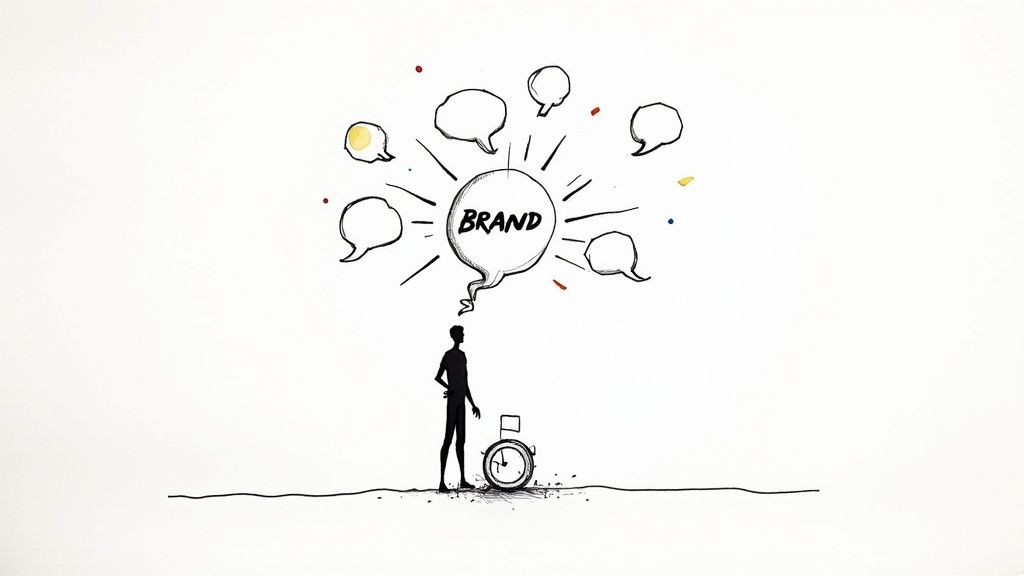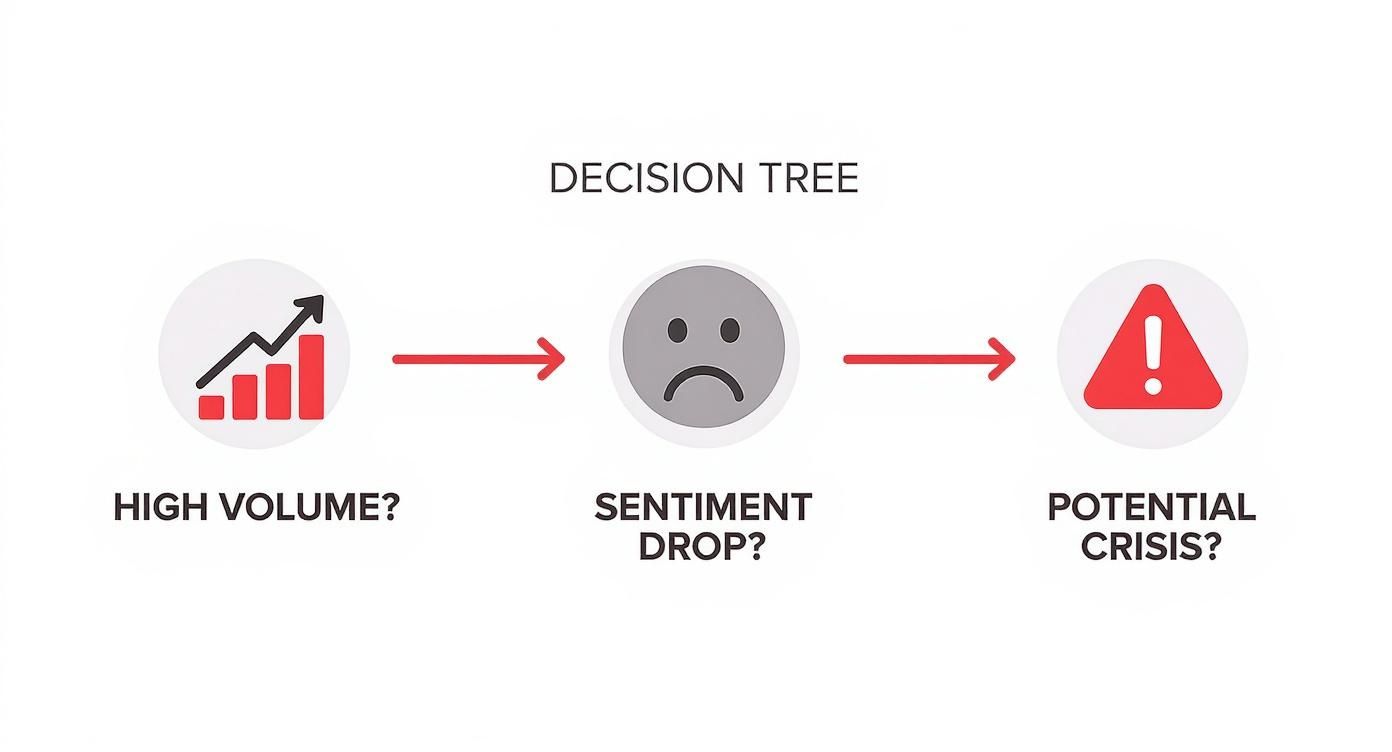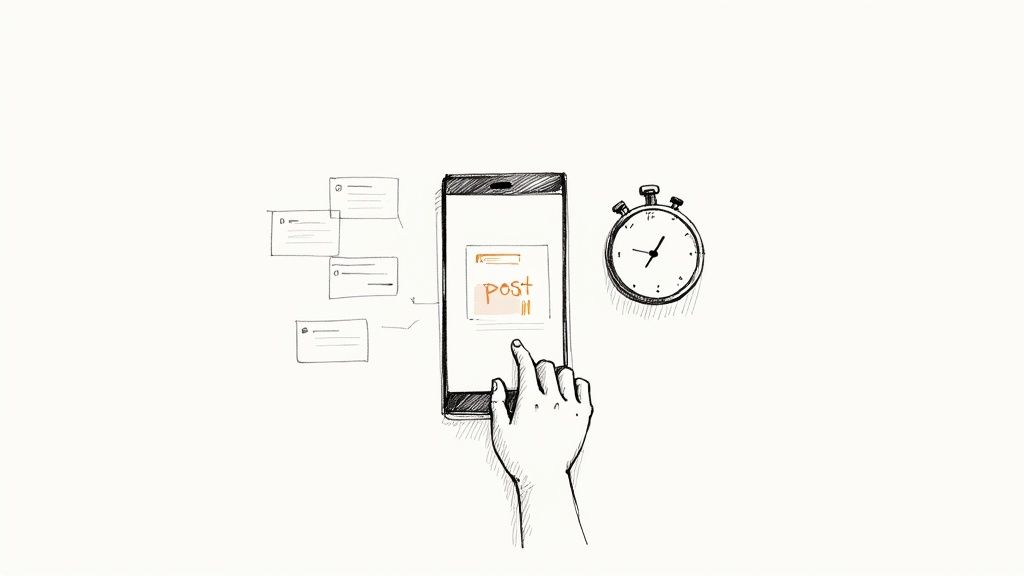When a crisis hits on social media, you’re not just managing a few angry comments. You’re fighting a wildfire of public opinion that can incinerate your brand’s reputation in hours. The problem is, you feel the intense pressure to respond perfectly, but the chaos and lack of a clear plan leave you and your team paralyzed. A slow, fumbling response is the fastest way to lose control.
Social media crisis management is about having a plan before the fire starts. It’s the strategy, the tools, and the team coordination needed to spot trouble, react with purpose, and put out the flames before they cause irreversible damage.
Your Dusty Crisis Plan Won’t Cut It Anymore

You’ve seen it happen. A single disgruntled customer post goes viral. A pre-scheduled tweet lands at the worst possible moment. Suddenly, your brand is the villain of the day, and the silence from your end is deafening while your team scrambles to figure out what to say. This is your biggest problem: the manual, high-pressure process of drafting a response from scratch while the world watches.
That “wait and see” hesitation? It’s a death sentence for your brand’s narrative. Every second your team spends in emergency meetings, trying to draft the perfect statement, and chasing down approvals is another second the public is defining who you are. This isn’t just a PR headache; it’s a direct hit to your bottom line.
The Staggering Cost of Slow Reactions
The fallout from a disorganized, delayed response is real and painful. We’re talking about lost trust, customer churn, and a brand image that could be tarnished for years. The numbers don’t lie: a shocking 46% of companies without a formal crisis plan lose over 20% of customer trust during an incident.
Think about that. One bad day online can wipe out a fifth of your hard-earned customer loyalty. It’s no wonder 68% of brands are now pumping more money into their crisis communication training. They know what’s at stake.
This is exactly where the old-school crisis binder, gathering digital dust in a forgotten folder, completely fails you. It can’t solve the core problem of speed and consistency required by social media.
A crisis playbook turns panic into a process. The single biggest mistake brands make is a lack of preparation, which always results in a slow, chaotic, and inconsistent response that destroys public trust.
Let’s be honest with ourselves for a moment. How prepared are you really?
Your Crisis Readiness Reality Check
Use this quick self-assessment to find the dangerous gaps in your current social media crisis management approach.
| Crisis Preparedness Area | Yes/No | Potential Impact If ‘No’ |
|---|---|---|
| Do you have pre-approved holding statements for common scenarios? | Scrambling to write and approve messages while the crisis escalates. | |
| Is there a clear escalation path to notify decision-makers 24/7? | Critical delays as the issue sits in an inbox overnight or on a weekend. | |
| Can you generate a first-response draft in under 5 minutes? | Losing control of the narrative as others define the story for you. | |
| Is your team trained to maintain a consistent brand voice under pressure? | Conflicting messages that confuse the audience and erode trust. | |
| Do you have a tool to monitor social media for brand mentions in real-time? | Discovering the crisis hours after it has already gone viral. |
If you answered “No” to any of these, you’re facing a critical vulnerability. It’s time to solve this.
From Panicked Scrambling to Confident Control
A modern crisis playbook is your brand’s early warning system and rapid-response unit rolled into one. It’s not about having a dusty PDF file; it’s about having the right systems wired into your workflow to execute that plan flawlessly when the pressure is on. The goal is to flip the script from reactive chaos to proactive, confident control.
This is precisely the problem EchoWriteAI was built to solve. It acts as your digital first responder, smashing the bottlenecks that lead to those costly, reputation-shattering delays.
Instead of staring at a blinking cursor, your team can:
- Solve the “Blank Page” Problem: Generate multiple on-brand, empathetic, and consistent holding statements in seconds with EchoWriteAI. No more writing from scratch in a panic.
- Maintain Your Authentic Voice: EchoWriteAI already knows your unique brand voice, solving the challenge of sounding robotic or inconsistent when things are hitting the fan.
- Leapfrog the Chaos: EchoWriteAI gives your team a set of powerful, pre-vetted responses to choose from while other brands are still stuck debating the first sentence.
By automating that initial, critical drafting stage, you empower your team to get ahead of the storm. This guide will walk you through building a crisis response system that works, integrating smart technology with a clear, actionable strategy. After all, having the right social media content creation tools isn’t just for sunny-day marketing; it’s what ensures you survive the storm.
Building Your Digital Early Warning System
You can’t fight a fire you don’t know exists. The problem for most brands is that the early warning signs—a single ticked-off customer, a misread tweet, a product bug mentioned on Reddit—get lost in the noise. By the time you notice, it’s a full-blown crisis. Trying to manually sift through thousands of daily mentions is a losing game. It leaves your reputation wide open.
The real challenge is that most brands are reactive. You wait for the smoke alarm to start screaming, but by then, the crisis is already trending and you’re playing defense. To solve this, you need an automated early warning system. Think of it as a digital listening post that doesn’t just hear the noise but actually detects the faint signals that come before the storm hits.
Moving Beyond Simple Keyword Alerts
Years ago, setting up a keyword alert for your brand name was enough. Not anymore. Today’s digital chatter is packed with sarcasm, slang, and indirect jabs that basic tools will fly right past. An effective early warning system needs to understand the emotional context around the words to solve your awareness problem.
This means getting more sophisticated with your social listening to track what really matters:
- Sudden Shifts in Sentiment: Is the general feeling about your brand suddenly tanking? A sharp, unexpected drop in positive sentiment—even if mention volume is stable—is a massive red flag. A 20% dip in sentiment inside of an hour should set off alarm bells.
- Spikes in Mention Velocity: Keep an eye on the rate of conversation. A sudden surge in how often you’re being mentioned, even if the tone seems neutral, tells you something has captured the public’s attention and you need to find out what it is, fast.
- Competitor Crises: Always monitor keywords related to your competitors’ train wrecks. This isn’t about being smug; it’s about seeing if the fire might jump over to your yard, especially if you’re in the same industry.
Configuring these parameters is the difference between being a digital archivist and a digital firefighter. You stop just collecting data and start acting on real intelligence.
Defining Your Crisis Thresholds
Look, not every negative comment is a five-alarm fire. If your team chases down every complaint, they’ll burn out. The secret is to establish clear, data-driven crisis thresholds that separate the everyday grumbling from a genuine, escalating threat. An issue only becomes a “crisis” when it trips a wire you’ve already set.
A crisis threshold is your tripwire. It’s the specific, measurable point where a negative trend is no longer just “customer feedback” and requires immediate escalation. Without this, your team is flying blind, relying on gut feelings instead of data.
Your thresholds should be a mix of hard numbers and qualitative triggers. For instance:
- Volume Threshold: Over 100 negative mentions about one specific issue pops up in a 3-hour window.
- Influencer Threshold: A negative post lights up from an account with more than 50,000 followers.
- Media Threshold: A verified journalist or a major news outlet mentions your brand in a negative story.
- Hashtag Threshold: A nasty, brand-specific hashtag (think #BrandNameFail) gets used more than 50 times.
These triggers take the emotion and guesswork out of the equation. When a threshold is met, the playbook opens, and the response is swift and organized—not panicked.
How EchoWriteAI Turns Data Into Action
The biggest problem with social listening has always been the sheer volume of noise. The alerts go off, but now your team is drowning in data, trying to figure out which fire to put out first. The delay caused by manually drafting a response is where you lose precious time.
This is exactly how EchoWriteAI solves this for you. As soon as your listening tools flag a potential crisis, EchoWriteAI analyzes the conversation’s context and sentiment. It doesn’t just dump raw data on you; it gives you the actionable intelligence you need.
More importantly, it helps you use AI for social media posts and end burnout by instantly drafting response options.
While your team scrambles to confirm the facts, EchoWriteAI has already generated several on-brand, empathetic holding statements. This gives you the power to act decisively, handle the worst threats first, and get a response out in minutes, not hours. Your warning system transforms from a passive alarm into an active defense mechanism, giving you the first-move advantage when every second counts.
Assembling Your Crisis Response Command Center
When a social media firestorm hits, the real danger isn’t just the angry mob outside your digital door. It’s the chaos breaking out inside.
Who has the final say on the public statement? Who’s watching the comment section? Who’s supposed to tell the CEO what’s going on? Your problem is that trying to answer these questions in the middle of a meltdown is a surefire way to make things worse. You get slow responses, mixed messages, and mistakes that can haunt your brand for years.
The solution is to shift from a panicked scramble to a structured, almost military-style command center. A clear chain of command gets rid of the confusion, making sure everyone knows their job long before the first alarm bell rings. This isn’t about adding red tape; it’s about gaining clarity and speed when every single second counts.
Defining Your Non-Negotiable Roles
Your crisis team is your first line of defense. Every role needs to be crystal clear, with one person owning each responsibility. This prevents people from stepping on each other’s toes or, even worse, letting critical tasks fall through the cracks. While your team might look a little different, these roles are absolutely essential.
- Social Media Manager: This is your person on the front lines. They’re glued to the social channels, spotting the threat and posting the approved messages. They are the tactical boots on the ground.
- Communications/PR Lead: The master strategist. They own the narrative, crafting the core message and official statements. They’re also the main point of contact for any media inquiries that come flooding in.
- Legal Counsel: The ultimate gatekeeper. In a high-stakes situation, every single word you post publicly needs a green light from legal. Their job is to protect the company from liability and keep a bad situation from getting legally worse.
- Customer Support Lead: The voice of empathy. This person coordinates the one-on-one responses to customers who are directly impacted, making sure they feel heard and moving sensitive conversations into private channels like DMs or email.
- Executive Sponsor: The final decision-maker. This is usually a C-suite leader who has the authority to sign off on major statements and strategic moves, especially when there are big financial or business implications on the line.
When these roles are assigned ahead of time, you don’t waste the first critical hour of a crisis just trying to figure out who needs to be on the call.
Creating Your Escalation Matrix
Let’s be real: not every negative comment is a full-blown crisis. Your team needs a dead-simple way to tell the difference between a small brush fire and an out-of-control wildfire. That’s your escalation matrix—a visual guide that removes the guesswork and tells your team exactly who to notify, and when.
This decision tree gives you a simplified look at an escalation path, showing how to decide if a spike in mentions combined with a nosedive in sentiment is just noise or a true crisis.

As you can see, it’s not just one thing. It’s the combination of high volume and intensely negative feeling that flips the switch from “monitor” to “all hands on deck.”
The biggest failure point in a crisis isn’t the lack of a plan; it’s the lack of a clear approval workflow. When legal, PR, and leadership are emailing document versions back and forth, you’ve already lost control of the narrative.
This is exactly where old-school methods completely fall apart. You can have the best people in the right roles, but if your approval process is a tangled mess of emails and conflicting Word docs, your response will grind to a halt.
Your Central Hub for Real-Time Approvals
The problem isn’t your people—it’s your process. That manual back-and-forth between legal, PR, and the executive team creates bottlenecks that are absolutely fatal in a crisis. This is the precise pain point EchoWriteAI was built to solve. It stops being just a content tool and becomes your crisis command hub.
Instead of descending into email chaos, EchoWriteAI’s workflow lets your team move with military precision:
- Instant Draft Generation: The second a threat is confirmed, EchoWriteAI can generate several on-brand, empathetic holding statements. Your PR lead gets to start with a nearly-finished draft instead of a terrifyingly blank page.
- Seamless Collaboration: The draft lives right inside EchoWriteAI. Legal, PR, and leadership can all log in, review it, and suggest edits in one place. No more saving files named “v2_final_FINAL_forrealthistime.”
- Real-Time Approval: The executive sponsor gets a notification, reviews the final, legally-vetted statement, and clicks “approve” directly in the platform. Your Social Media Manager is alerted instantly and can deploy the message across all channels at once.
This integrated system collapses a process that often takes agonizing hours into just a few minutes. You completely bypass the chaos and ensure your first public response is fast, unified, and signed-off on by everyone who matters. And while figuring out social media manager costs can be tricky, giving them tools that make them exponentially more effective during a crisis delivers an ROI you can’t put a price on: your brand’s reputation.
Crafting the Perfect First Response in Minutes

The first sixty minutes of a social media crisis are everything. Your problem is that the immense pressure to say the perfect thing often paralyzes your team into doing the worst possible thing: saying nothing at all.
That hesitation is a brand’s mortal enemy. While your team is holed up in an emergency meeting wordsmithing a statement, the court of public opinion is already delivering its verdict. A quick, well-crafted first response stops the bleeding, quiets the speculation, and proves to your audience that you’re present, accountable, and in control.
The Anatomy of a Powerful Holding Statement
Think of a holding statement as your first public acknowledgment. Its job isn’t to fix the problem on the spot, but to buy you precious time to investigate while reassuring everyone watching. Forget those flimsy, generic templates. A truly effective initial response has three core elements that build instant credibility.
- Acknowledge the Situation: Be direct. State clearly that you are aware of what’s happening. No jargon, no defensive posturing. A simple, “We are aware of the reports regarding X and are looking into it immediately” lands much better than some vague, corporate-speak nonsense.
- Express Genuine Concern: Empathy isn’t optional. Your audience needs to know you understand the impact. Using phrases like, “We understand this is concerning” or “We sincerely apologize for the frustration this has caused” shows you’re connecting on a human level, not just a business one.
- Outline Immediate Next Steps: Tell people what you’re doing right now. This isn’t about making grand promises; it’s about immediate action. Let them know, “Our team is actively investigating to understand the full scope of the issue. We will provide a more detailed update by 3 PM ET.” This sets clear expectations and shows you have a process.
The goal of your first response is not to have all the answers. It’s to show you’re taking ownership of the question. Silence creates a vacuum that will be filled with speculation and anger.
Tailoring Your Message for Each Platform
A copy-paste statement is a rookie mistake. The tone and format must be adapted to the platform where the fire started. What works on the professional, more formal landscape of LinkedIn will completely miss the mark on the rapid-fire chaos of Twitter.
- Twitter/X: Speed and brevity are king. Your statement needs to be concise and direct. Pin it to your profile for maximum visibility. You can always use a thread for follow-up details as they come in. For more on this, check out our guide on how to tweet effectively.
- LinkedIn: The audience here expects a more buttoned-up, detailed response. You have more character real estate to explain the context and underscore your commitment to fixing things, which is perfect for B2B or corporate-level crises.
- Instagram/Facebook: It’s a visual world. A simple text graphic with your statement can cut through the feed’s noise far better than a long, dense caption. If the crisis is severe, a raw, direct-to-camera video from a leader can be incredibly powerful in conveying genuine sincerity.
The EchoWriteAI Advantage: From Blank Page to Perfect Post in Seconds
And here’s where most teams stumble. The sheer pressure of drafting, editing, and getting multiple approvals on that all-important first message can stretch into hours—time you just don’t have. Your team is staring at a blinking cursor while your brand’s reputation is in a freefall.
This is the exact problem EchoWriteAI was built to solve.
Instead of panicking, your team can instantly generate several holding statement options, all tailored to your specific situation and infused with your unique brand voice. EchoWriteAI solves your “blank page” problem by understanding the delicate balance of empathy, accuracy, and tone, serving up powerful, pre-vetted responses to choose from.
While other brands are still stuck in a painful back-and-forth of approval chains, you can have a confident, on-brand message live in minutes. You get to take back control when it matters most.
Moving Past the Crisis: How to Rebuild and Fortify Your Brand

Getting through the first 24 hours of a social media firestorm feels like a victory, but it’s really just the start of the marathon. What you do next—in the days and weeks that follow—is what truly defines your brand’s resilience and character. The problem is that many companies make the same mistake: they drop a single, well-crafted apology and then go radio silent, hoping the world moves on.
That silence? It’s deafening. Your audience doesn’t see it as letting things cool down; they see it as indifference. It allows anger and suspicion to linger, poisoning any goodwill you might have earned with your initial response. True recovery isn’t about surviving the storm; it’s about deliberately and thoughtfully rebuilding what was broken.
Set a Rhythm for Your Follow-Up Communication
Once the immediate chaos subsides, you can’t just flip a switch back to your regular content schedule. Your audience is watching you under a microscope. They need to see you’re actually doing the work, not just saying the words. The best way to solve this is by establishing a predictable cadence for your updates. This keeps you in control of the narrative and proves you aren’t hiding.
A solid post-crisis communication plan should look something like this:
- Promise and Deliver Updates: Tell your audience when you’ll have more information. A simple, “Our team is investigating this thoroughly, and we will provide our next update by Friday” works wonders. It manages expectations and stops the flood of “any update??” comments.
- Talk About Actions, Not Just Feelings: Go beyond saying “we’re sorry.” Tell them what you’re doing. For instance, “We’ve launched a full internal review of our content approval process to ensure this never happens again.”
- Share What You’ve Learned: Be as transparent as you can about the root cause (while respecting legal and privacy boundaries, of course). Admitting where you messed up is a surprisingly powerful way to start earning back trust.
This consistent follow-through is where many teams drop the ball. They’re burned out from the crisis and unsure of the next right thing to say. The manual grind of drafting, approving, and posting these delicate messages can feel overwhelming, which is exactly when that dangerous silence creeps in.
Turn Customer Feedback into Fuel
That post-crisis period is an absolute goldmine of honest feedback. The comments are raw, unfiltered, and incredibly valuable if you’re willing to listen. Your job is to stop being defensive and start engaging constructively, turning your biggest critics into your most helpful consultants.
Treat every piece of negative feedback as a free lesson. Keep an eye out for recurring themes and specific suggestions. And when you actually make a change based on what people have said? Announce it. A post that says, “You spoke, and we listened. Based on your feedback, we’re making this change effective immediately,” is one of the most powerful moves you can make. It shows you respect your community and are committed to real change.
A crisis isn’t over when the negative comments stop. It’s over when you’ve fully understood what went wrong, made concrete changes to prevent it from happening again, and clearly communicated those changes to everyone who was watching.
The Post-Mortem: Turning Pain into Progress
This is where the real growth happens. A thorough post-mortem analysis isn’t optional; it’s essential. Get the entire crisis team in a room and ask the tough questions. Where did our process fail? What blind spots did we have? How can we be faster, smarter, and more prepared next time? This turns a painful, public failure into a powerful lesson that fortifies your entire organization.
This focus on improvement is driving huge investments across the industry. In fact, the market for social media crisis management tools and services shot past $1.88 billion in 2023 and is projected to climb by nearly 21% annually through 2032. Why the surge? Brands are finally adopting AI for real-time analysis and using data to guide their recovery strategies. You can read the full research about the expanding market to see how AI is changing the game.
This is exactly where a tool like EchoWrite AI becomes your partner in recovery. It solves the problem of “what do we say next?” by helping you craft consistent, reassuring follow-up messages. EchoWrite AI analyzes public sentiment in real-time, giving you data-backed insights on whether your tone is landing, if trust is actually being rebuilt, and where you need to pivot. It helps you prove to leadership that you haven’t just managed a crisis—you’ve successfully rebuilt brand health with measurable results.
Common Questions in the Heat of a Crisis
When the proverbial fire starts, a few key questions always come up. Forget the textbook theories—when your brand’s reputation is hanging by a thread, you need answers that work in the real world, and you need them fast. Let’s tackle the big ones.
How Fast Do We Really Need to Respond?
You need to be public with some form of acknowledgment in under 60 minutes. That first hour is everything.
You’re not expected to have a complete solution in that time. The goal is simply to show up, acknowledge the issue, and let people know you’re on it. This simple act stops the runaway train of speculation and shows your audience you’re not hiding.
Your biggest problem is getting tripped up in a multi-departmental approval vortex. That silence is deafening and allows others to control your story. This is where a tool like EchoWriteAI is the perfect solution. It can generate a calm, empathetic holding statement in seconds, letting you get something out there while the team works on a more detailed response. Speed shows you’re present; silence suggests you’re guilty.
Should We Just Delete the Negative Comments?
I know the temptation is massive, but don’t do it. Hitting that delete button is like pouring gasoline on the fire.
It almost always backfires, turning a customer service issue into a full-blown scandal about censorship. It signals you have something to hide and can trigger the Streisand Effect, where your attempt to suppress something only makes it spread further and faster.
The only time you should delete is for comments containing genuine hate speech, credible threats of violence, or private information (doxing). Anything else, even harsh criticism, needs to stay.
Your best bet is to address the valid points head-on. Acknowledge the criticism publicly and offer to take the conversation to DMs to resolve the specifics. Transparency builds trust; a sanitized comments section just builds suspicion. Handling criticism with grace is a core part of solid crisis management on social media.
What’s the Single Biggest Mistake a Brand Can Make?
Hands down, the biggest mistake is not having a plan. Winging it during a crisis is a surefire recipe for disaster.
Without a playbook, established roles, and some pre-approved messaging frameworks, your team is left scrambling under immense pressure. This chaos leads to conflicting messages, awkward delays, and a general vibe of incompetence that absolutely erodes public trust.
A good crisis plan turns that panic into a process. When you use a tool like EchoWriteAI to solve the problem of drafting that first response, you ensure your first move is fast, consistent, and on-brand. Being proactive is the difference between leading the conversation and being flattened by it.
Tired of that deer-in-the-headlights feeling when a crisis hits? EchoWriteAI is your secret weapon. You know the problem: the pressure to respond perfectly but being frozen by the blank page. EchoWriteAI solves that. It acts as your instant first responder, drafting empathetic, on-brand statements in minutes so you can reclaim the narrative and protect your reputation. Stop dreading the next crisis and start outsmarting it.
Discover how EchoWriteAI can safeguard your brand today at echowriteai.com

 Martín Véliz
Martín Véliz 


